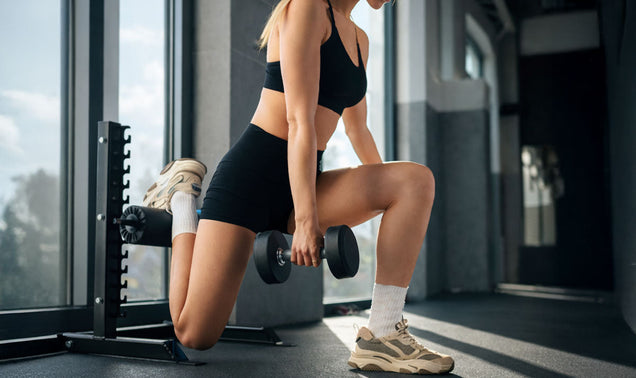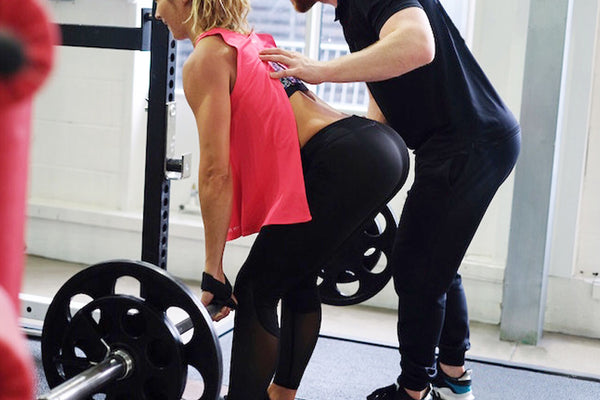How many times have you gone to the gym and seen some guy on the bench press who’s squirming, flailing, and turning 50 shades of red and purple as he tries to press the weight up while another guy stands on top of him trying to pull the bar up?
Is this some kind of weird couples workout?
Not quite.
What you witnessed is two things:
- A lifter who let their ego get the better of them, and
- A spotter who saved the lifter from getting crushed.
In this article, we’ll discuss what a spotter is and why you should train with one the next time you’re about to crush a workout.
What is a Spotter?
A spotter is someone who supports another person during a weight lifting exercise, with the emphasis being on the person performing the actual lift. If the lifter’s technique starts to falter and it appears they may fail (i.e. get crushed by the bar), the spotter steps into assist them with finishing the rep and safely racking the weight.
A spotter is not someone there to help you lift the weight on every rep of every set. If that is why you are using a spotter, then you need to lighten the weight and use an appropriate load that allows you to lift with good form on your own.
The spotter only is there to ensure your safety and bail you out if it looks like you might fail on the last rep or two of your working set.
Basically, the mark of a good spotter is one who knows when to get involved in the lift and assist and when to stand by and encourage.
7 Reasons You Should Train with a Spotter
Safety
The #1 goal and responsibility for a spotter is to ensure the safety of the lifter.
If you’re relatively new to free weight compound exercises with a barbell, training with a spotter can help you avoid injury by monitoring your form and stepping in to assist you with the weight when your form starts to get spotty.
Spotters are also a great fail-safe when attempting a new PR either in weight or reps as you are pushing your body past its usual limits, increasing the likelihood of failure and potential injury.
Motivation
Spotters can give words of encouragement and motivation before or during an exercise, which may help you to push harder and last longer before terminating a working set. And, by banging out more reps with more weight, you’ll make greater progress in your workouts, helping to build muscle and burn fat.
Confidence Booster
Attempting barbell lifts for the first time or even trying to set a new 1-rep max or rep PR can be fairly intimidating. Having a trusted spotter next to you can be a confidence booster (even if they’re not touching the bar), enabling you to push harder than normal, with the confidence that if your technique starts to falter, you’ll have your buddy right there to bail you out.
Having a spotter may also give you the confidence to try a new exercise that you may not have tried previously when you were training by yourself.
Exercise Form Improvement
It can be difficult when you’re training by yourself to know if your lifting technique is 100% spot on. Having a spotter close by can assess your movement patterns and offer feedback on where you can improve. They can also identify the portions of the lift where you are weakest, and with this knowledge, you can incorporate accessory movements to improve your sticking points and become a stronger, more proficient weight lifter.
Enjoyment
Some people enjoy training alone, and others abhor it. Training with a partner can bring a new level of enjoyment, excitement, and enthusiasm to your workouts. And, with greater enthusiasm comes a greater desire to push yourself harder in your workouts, ultimately yielding better results.
Training Past Failure
At the outset, we said a spotter’s job is not to lift the weight for the lifter on every rep of every set, and that still holds true 99.999% of the time.
The one instance when having a spotter assist with lifting the weight is when you are trying to improve your strength and incorporate overloading eccentrics into your workouts.
Our muscles are stronger in the eccentric (lowering) phase of a lift than the concentric (lifting) phase. What this means is that while we may reach “concentric failure” during a given exercise (meaning we can no longer lift the weight), our muscles still have enough energy and strength to continue “resisting the weight down.”
Therefore, when performing this advanced weight lifting technique, once you reach positive concentric failure, a spotter steps in to help you lift the weight on each set, but you are responsible for controlling the weight during the lowering portion.
Overloading eccentrics are great if you’re trying to improve strength (as it gets the CNS used to deal with heavier loads than normal), or build muscle (as you can create more metabolic stress and muscle damage).
You Have a Spotter
When you train with a spotter, you don’t have to worry about walking up to strangers at the gym to ask for a spot or if they know how to properly spot you.
How to Be a Good Spotter
Stay Focused
If you are spotting for someone, your top priority is ensuring the safety of your fellow lifter.
Like Jester told Maverick in Top Gun, “You never, never leave your wingman.”
As such, while they’re under the bar, your attention should be entirely devoted to them.
No checking your phone.
No snapping selfies.
No checking out people on the cardio machines.
You focus on the person you are spotting and nothing else. Make sure the lifter is using proper form, and if it looks like they are performing the exercise in a manner that may lead to injury, make sure to stop the set and address the issue.
Know When (and When Not) to Spot
The mark of a good spotter is one who knows when it’s time to help a lifter out. Jumping in too soon to help a lifter robs them of quality muscle-building reps as well as knowing how hard they can actually push themselves before they truly need a spotter.
Once you do step in to assist a lifter, you want to use as little assistance as possible. Remember, the lifter is supposed to be doing the work here. You are there to ensure their safety and make sure they don’t get crushed by the bar if their technique starts to waver.
Clear Communication
Part of being a good spotter is talking with your partner and knowing what they hope to accomplish with their workout -- how many reps, how many sets, what exercises, etc.
It’s also important to know what kind of motivation the lifter wants.
Are they the kind who likes to be yelled at while lifting, or do they prefer more positive, calm reinforcement in between their working sets.
Having clear lines of communication ensures safety and an enjoyable workout experience for both of you.
Takeaway
Having a spotter helps ensure safety and allows you push harder (safely) in your workouts. Clear communication between you and the spotter is absolutely essential. And, the most important facet of being a spotter is knowing when to help out and when to let the lifter grind it out.
Make sure you supplement your workouts correctly to solidify the progess you make. Browse our supplements for workout improvement to find what you need.






